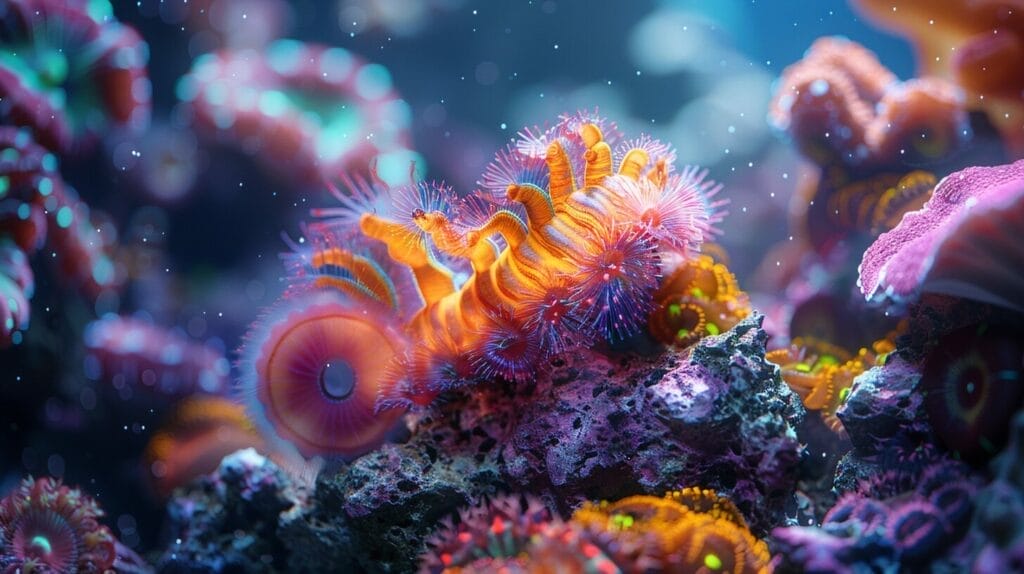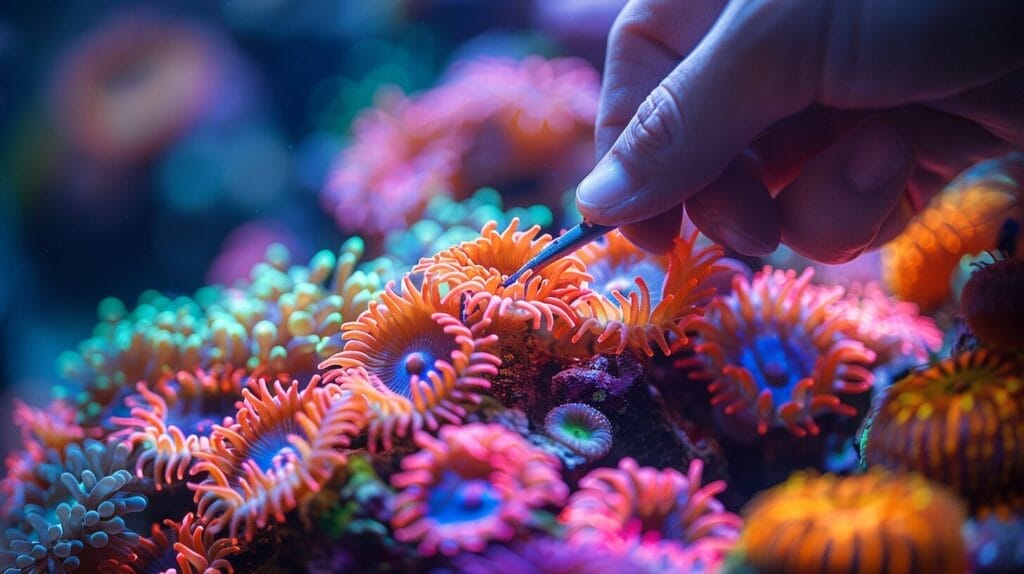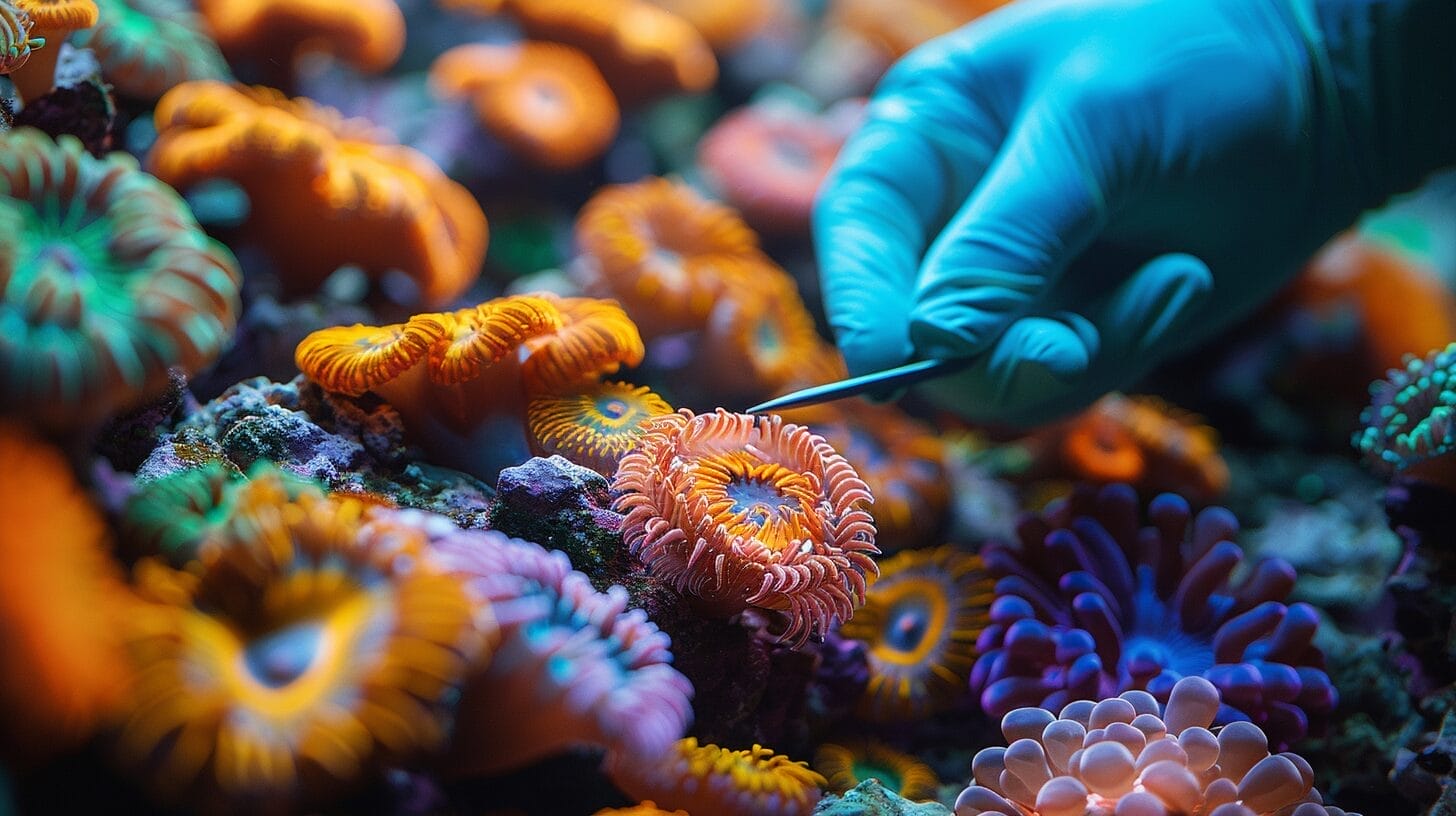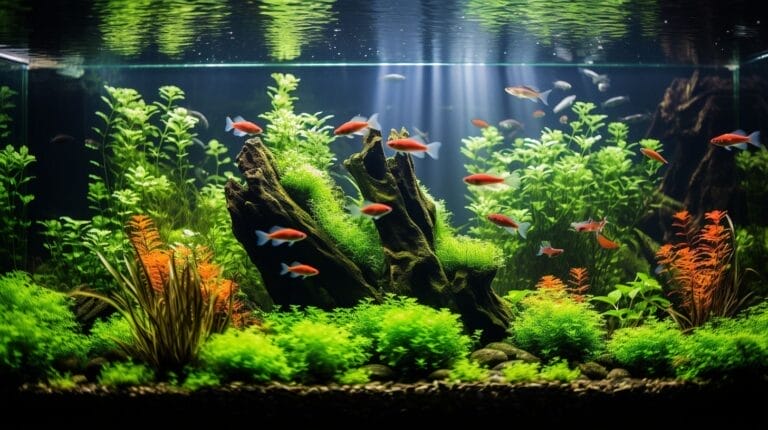Bristle Worms in Reef Tank: How to Deal with Polychaete
Dealing with bristle worms in your reef tank? Avoid overfeeding to control their numbers. Offer hiding spots for them. Watch for signs of overpopulation in the substrate. Remove extras using traps or bait. Aim for a balanced ecosystem. Need more tips for managing polychaetes in your tank?
Explore strategies like identifying different types and evaluating their impact on corals and live rock. Get rid of fireworms by inspecting regularly, using tweezers, and maintaining tank hygiene. Act fast to keep your tank’s harmony.
Key Takeaways:
- Bristle worms clean reef tanks by eating waste.
- Avoid overfeeding to control bristle worm growth.
- Watch out for fireworms’ venomous bristles.
- Check tank regularly for bristle worm overpopulation.
- Use traps to manage bristle worm numbers.
Understanding Bristle Worms in a Reef Aquarium

When setting up your reef aquarium, understanding the role of bristle worms is crucial for maintaining a balanced ecosystem. Bristle worms, also known as polychaete worms, are common inhabitants of saltwater marine aquariums.
Despite their appearance, with bristles along their bodies, these creatures play an important role in your tank. Many species are beneficial scavengers, helping to clean up detritus and uneaten food, thereby contributing to the overall health of your aquarium.
It’s important to note that while most bristle worms are helpful, some larger species can potentially become predators, feeding on small fish or other tank inhabitants. However, in a well-balanced reef tank, the presence of bristle worms is generally a sign of a healthy ecosystem.
Identifying Different Types of Bristle Worms in Your Aquarium

What important features can help you identify different types of bristle worms in your aquarium?
Bristle worms are marine segmented worms that often dwell in reef tanks, with the common bristle worm being a typical sight. These worms have bristles along their bodies, aiding in movement and defense. While most bristle worms are detritivores and help clean up excess food and waste in your tank, some species like fire worms can be harmful.
Fire worms are usually brightly colored, with distinct patterns and are equipped with venomous bristles that can cause irritation. A specific type of fire worm to watch out for is the bearded fireworm, recognizable by its beard-like bristles that can pack a painful sting. Understanding the appearance and behaviors of these different types of bristle worms is essential in determining whether they’re beneficial or harmful inhabitants of your aquarium.
Evaluating the Impact of Bristle Worms on Coral and Live Rock

Bristle worms in your reef tank can have varying impacts on the health and stability of coral and live rock. Here’s how they interact with these elements:
- Coral Reefs: Bristle worms typically scavenge on decaying matter in your tank, which can sometimes include bits of coral. While they may nibble on unhealthy or dying coral, they generally don’t harm healthy corals. However, in large numbers, they might stress the corals.
- Live Rock: Bristle worms play an important role in cleaning up detritus and algae on live rock. They help maintain the balance of your tank by breaking down organic matter and preventing the buildup of waste. However, excessive populations could potentially damage the aesthetics of the live rock.
- Impact Assessment: If your coral and live rock are healthy and thriving, the presence of bristle worms mightn’t be a cause for concern. Regular monitoring and ensuring a balanced ecosystem will help you determine if their impact is positive or needs management.
Managing Bristle Worms in Your Reef Tank: Prevention and Control

To effectively manage bristle worms in your reef tank and maintain a healthy ecosystem, it’s essential to implement techniques for preventing overpopulation and controlling their numbers.
Bristle worms play an important role in marine ecosystems, acting as good scavengers that help clean up excess food and debris. To prevent an overwhelming bristle worm population, make sure you have a balanced ecosystem by not overfeeding your tank. Additionally, provide hiding spots like PVC pipes or rock structures to encourage them to stay in manageable numbers.
Regularly check your substrate for signs of overpopulation, such as visible bristle worm segments or an increase in their activity during feeding times. If necessary, manually remove excess bristle worms using traps or bait methods to keep their numbers in check.
How Do Bristle Worms Affect the Care of Bristlenose Plecos in an Aquarium?
Bristle worms can negatively impact bristlenose plecos care for aquarium. These creatures can be aggressive towards smaller fish and may damage the plecos’ sensitive fins. It’s important to regularly monitor the aquarium for bristle worms and remove them promptly to ensure the well-being of the bristlenose plecos.
Dealing with Fireworms in Your Reef Aquarium

Dealing with fireworms in your reef aquarium requires a vital approach to prevent any potential risks to your tank’s ecosystem. These creatures, known for their sharp bristles and potentially harmful behavior, can disturb the delicate balance of your reef tank if left unchecked. Here are three essential steps to effectively manage fireworms in your aquarium:
- Identify the Problem: Regularly inspect your reef tank for any signs of fireworms. Look out for their distinctive appearance and behavior, such as aggressive movements or damage to coral and other tank inhabitants.
- Remove Fireworms Safely: If you spot a fireworm in your aquarium, it’s important to act swiftly. Use specialized tools like tweezers to carefully remove the fireworm from your tank without causing harm to yourself or the creature.
- Implement Preventative Measures: To prevent future infestations, maintain good tank hygiene practices, such as regular water changes and avoiding overfeeding. Additionally, consider introducing natural predators of fireworms, like certain species of fish or shrimp, to help keep their population in check.
Conclusion
Overall, dealing with bristle worms in your reef tank can be manageable with proper prevention and control measures. By understanding the different types of bristle worms and their impact on your coral and live rock, you can effectively manage their population.
Regular maintenance and keeping an eye out for fireworms can help keep your reef aquarium healthy and thriving. Remember, a little bit of knowledge and proactive measures can go a long way in maintaining a successful reef tank.
Frequently Asked Questions
What are bristle worms and why are they found in reef tanks?
Bristle worms are marine worms that belong to the polychaete phylum. They are commonly found in saltwater aquariums as they help keep the tank clean by feeding on detritus and other organic matter.
How can I identify a fireworm in my reef tank?
Fireworms are a type of bristle worm with reddish coloration and distinctive white and red bristles. They are known to be aggressive and may target small fish as prey.
Are bristle worms good or bad for my reef tank?
Bristle worms can be beneficial if they are the good type, as they help in maintaining the tank’s ecosystem by eating waste. However, bad bristle worms like fireworms can be harmful to other tank inhabitants.
How do bristle worms reproduce in a reef tank?
Bristle worms reproduce by releasing gametes into the water, where fertilization takes place. The larvae then develop and settle in the tank substrate to grow into adult worms.
What are some methods for removing bristle worms from a reef tank?
You can manually remove bristle worms by using a net to scoop them out of the tank, especially when they become a nuisance. Another method is to lure them out with bait in a trap.







